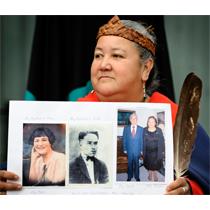By Norma Greenaway
Canada.com
November 25, 2008
http://www.canada.com/topics/news/story.html?id=2b316795-c79b-4b05-bc65-a03f0a0ef9ba
Many survivors of Canada's Indian residential schools say they ache to tell their stories to a federal commission charged with exploring the system's legacy, but what about the aboriginal boys and girls who did not survive? Who will tell their stories?
Historian John Milloy says that if all goes according to plan, the living will share - orally or in writing - what they know about the deaths and burials of their former classmates, many of whom ended up in unmarked graves dug by their fellow students on the grounds of the schools they attended.
 |
| Jeanette Baker, 50, holds a picture of her ancestors who suffered in residential schools. Questions remain as to how their stories will be told. |
Those stories will be added to information gleaned from records contained at dozens of church and government archival sites across Canada, Milloy said Tuesday in an interview.
Milloy, author of A National Crime, the Canadian Government and the Residential School System 1879 to 1986, was an adviser to the working group of church, aboriginal and federal government representatives that has laid out for the Truth and Reconciliation Commission a plan for filling in huge gaps in information about how many children died, what they died of and where they are buried.
The working group's proposed research project has been approved and the commission is committed to implementing it, Kimberly Phillips, spokeswoman for the commission, said Tuesday in an e-mail.
However, with no budget, and a commission hobbled by the surprise resignation last month of its chairman, Justice Harry LaForme, the project is not off the ground.
Milloy said he's hopeful the work will proceed and that it will be done by independent historians and archivists so there is no perception - real or imagined - of tainted findings.
Milloy said he's convinced survivors are keen to help fill in the blanks of what happened to fellow students and to help answer questions that haunt the surviving parents and siblings of the missing or dead.
"I get it every time we sit around for coffee and there are survivors in the room. Out come the stories about the kid that ran away and nobody has ever seen him again, about the child who was taken to the infirmary and died and so on. They know names, they know places and they know dates," he said.
Milloy said the commission risks being dismissed by aboriginals and others unless it documents the missing and dead as well as possible, and puts an end to "ridiculous" allegations that thousands of aboriginal children were used in medical experimentation, purposely infected with tuberculosis or even murdered in a bid to "end the Indian problem."
Milloy, a professor at Trent University in Peterborough, Ont., said the legacy must be put in the proper historical context.
"There is no doubt about it, we are going to hang the smelly horseshoe around the federal neck. There's no doubt they are responsible for the neglect of thousands of children and the consequences that flowed from that neglect, And some of that was death. And some of that was shortened lives. And some of that is an inability to function after graduation," he said. "They knew all this from very early on. Yet they persisted in the system, and that's enough of a guilty verdict as far as I am concerned."
The important thing now that the federal government has apologized and negotiated a compensation package is to move ahead with the commission's quest for truth and reconciliation, he said.
Milloy says tuberculosis was the most common cause of death in the crowded and under-funded schools, but that other illnesses, accidents and suicides added to the toll.
Once the graveyards and burial grounds are located and documented, the working group's plan envisions traditional aboriginal ceremonies being conducted at the sites to "ask the spirits of the missing children" to return home to their communities.
The second phase of the massive research project is more ambitious and complicated because it would require the provinces to open up confidential and sensitive files. It would be aimed at tracking what happened to the youngsters who left the boarding schools and ended up in hospitals, foster care or elsewhere "without the knowledge of their parents."
Any original material on these pages is copyright © BishopAccountability.org 2004. Reproduce freely with attribution.